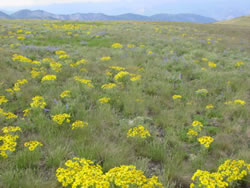Plant of the Week
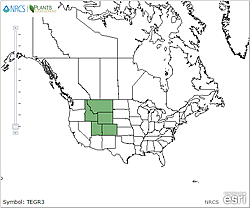 Tetraneuris grandiflora range map. USDA PLANTS Database.
Tetraneuris grandiflora range map. USDA PLANTS Database.
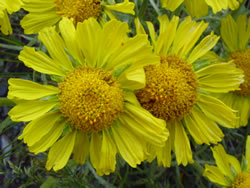 Old Man in the Mountain / Alpine Sunflower (Tetraneuris grandiflora). Photo by James Henderson.
Old Man in the Mountain / Alpine Sunflower (Tetraneuris grandiflora). Photo by James Henderson.
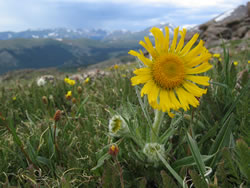 Old-man-of-the-mountain is hard to miss in the alpine tundra. Photo by Andrew Kratz, Forest Service.
Old-man-of-the-mountain is hard to miss in the alpine tundra. Photo by Andrew Kratz, Forest Service.
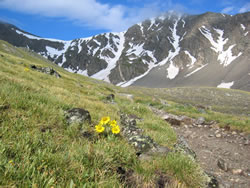 Named by John Torrey and Asa Gray, old-man-of-the-mountain stands below Torrey’s Peak (14,267 feet) in Colorado. Gray’s Peak (14,270 feet) is on the left, with the summit just out of view. Photo by Andrew Kratz, Forest Service.
Named by John Torrey and Asa Gray, old-man-of-the-mountain stands below Torrey’s Peak (14,267 feet) in Colorado. Gray’s Peak (14,270 feet) is on the left, with the summit just out of view. Photo by Andrew Kratz, Forest Service.
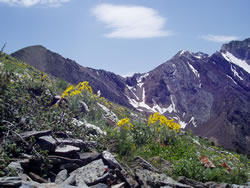 Alpine sunflowers on Railroad Ridge, Idaho. Note the blooms are all facing east to maximize their exposure to the sun. Photo by Jeff Motychak.
Alpine sunflowers on Railroad Ridge, Idaho. Note the blooms are all facing east to maximize their exposure to the sun. Photo by Jeff Motychak.
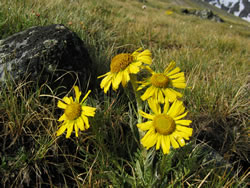 Basking in the sun, well above timberline. Photo by Andrew Kratz, Forest Service.
Basking in the sun, well above timberline. Photo by Andrew Kratz, Forest Service.
Old-Man-of-the-Mountain (Tetraneuris grandiflora)
By Andrew Kratz and Charmaine Delmatier *
This handsome wildflower cannot easily be missed by hikers in much of the alpine tundra from Idaho and Montana to Utah and Colorado. The stout stems are covered with woolly white hairs, and the solitary yellow flower head is large enough to dwarf the rest of the plant. The early bloomers are only a few inches tall, but later in the summer plants can reach nine or ten inches in height.
Some species in the sunflower family have flowers that face toward the sun, slowly following as it traces an arc across the sky. But the old-man-of-the-mountain always faces east (except for the occasional odd man out!), which makes this plant a potentially useful guide to a lost hiker on a heavily overcast or foggy day (Safety First: always carry your compass).
Also known as alpine sunflower, Old-Man-of-the-Mountain gets its name from a distinguishing characteristic: its hairs. Long villous woolly hairs cover much of the soft feathery leaves and a soft tomentose of shorter densely tangled hairs coat the peduncle (a stem-like structure that subtends each flowering head or involucre). A member of the sunflower family, Asteraceae, Old-Man-of-the-Mountain displays one of the showiest-brightest yellow-flowering heads in open areas of the alpine. It stands no taller than 12 inches, but the bundle of 1 to 10 flowering heads can also reach as wide as a foot. As the plant matures, its yellow vibrant color fades to tan. The enjoyment of seeing this spectacular alpine sunflower is that where it grows it can be locally abundant producing a refreshing display of color amidst the rocky gray landscape.
The history of its nomenclature, specifically the genus, has been an active and somewhat complicated history, with its name being changed periodically over the years. John Fremont while exploring with Kit Carson in the Wind River Range of Wyoming in 1842 made the first scientific collection of this plant. John Torrey and Asa Gray named it Actinella grandiflora in 1845. Later in 1898, Edward Greene renamed it to Rydbergia (named after Per Axel Rydberg, first Curator of the New York Botanical Garden and well-established field botanist in the Rocky Mountains). In 1980, K. L. Parker changed its name to Hymenoxys, and then again to its current nomenclature Tetraneuris as described and accepted in the new treatment within The Flora of North America. Its specific epithet has remained the same ‘grandiflora’, which translates from Latin into ‘large-flowered’.
Known from north central United States in the Intermountain Regions and Rocky Mountains, it can be found in an alpine environment of Colorado, Idaho, Montana, Utah, and Wyoming. The flowering season is short, usually between June to August, depending on the spring snow thaw and then again before the first frost of fall. Surviving the cold winds, threats of desiccation, and strong sun rays of high mountain altitudes, Old-Man-of-the-Mountain surpasses all environmental hardships with a sense of ease. Standing strong and robust above timberline, the bright yellow involucres are shaped as a hemisphere and the phyllaries are arranged in series of 2-3 with long tapering tips (acuminate). The number of ray florets can range from 15 to 34 and there can be as many as 150 to 400 disc florets.
A poultice of prepared root from one of its relative, pingue hymenoxys (Hymenoxys richardsonii) has been used for skin rashes and sores, and an infusion of its root has been reported to aid in stomachaches.
Seed is available commercially for the home gardener.
For More Information
* Note: This species was originally presented on Celebrated Wildflowers in July 2015; then, by Andrew Kratz. This article is updated with more information and pictures by Charmaine Delmatier (2014) and presented again in February 2017.


